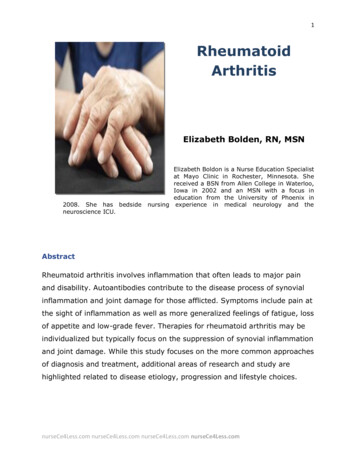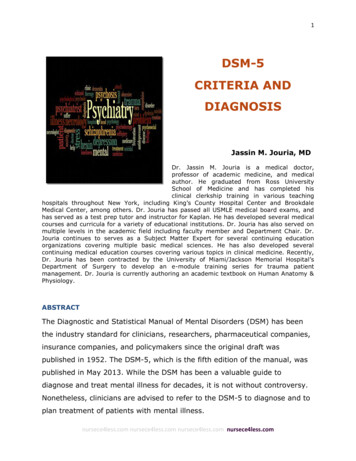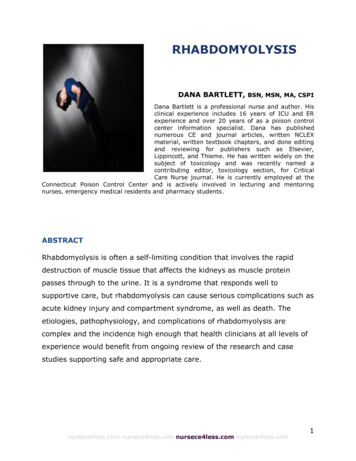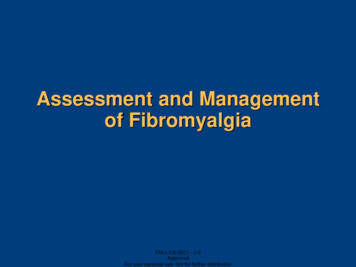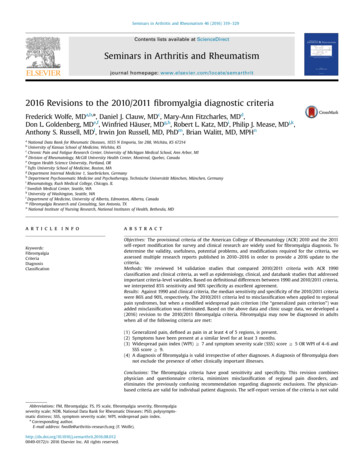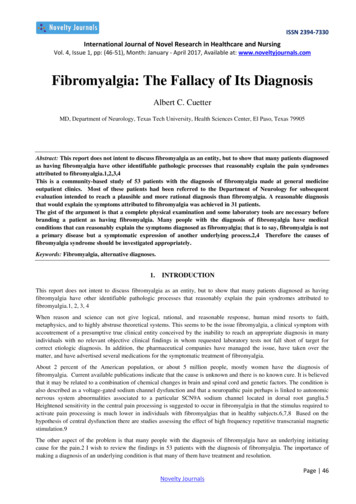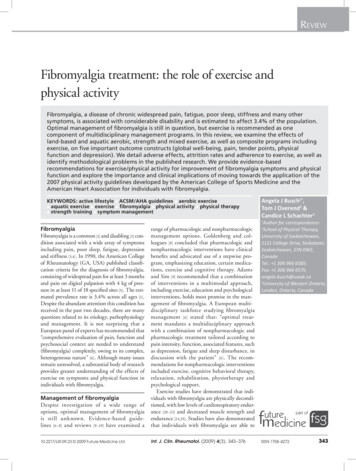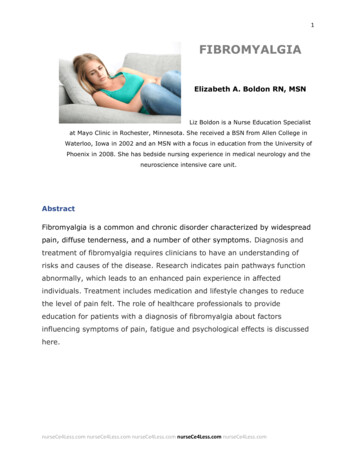
Transcription
1FIBROMYALGIAElizabeth A. Boldon RN, MSNLiz Boldon is a Nurse Education Specialistat Mayo Clinic in Rochester, Minnesota. She received a BSN from Allen College inWaterloo, Iowa in 2002 and an MSN with a focus in education from the University ofPhoenix in 2008. She has bedside nursing experience in medical neurology and theneuroscience intensive care unit.AbstractFibromyalgia is a common and chronic disorder characterized by widespreadpain, diffuse tenderness, and a number of other symptoms. Diagnosis andtreatment of fibromyalgia requires clinicians to have an understanding ofrisks and causes of the disease. Research indicates pain pathways functionabnormally, which leads to an enhanced pain experience in affectedindividuals. Treatment includes medication and lifestyle changes to reducethe level of pain felt. The role of healthcare professionals to provideeducation for patients with a diagnosis of fibromyalgia about factorsinfluencing symptoms of pain, fatigue and psychological effects is discussedhere.nurseCe4Less.com nurseCe4Less.com nurseCe4Less.com nurseCe4Less.com nurseCe4Less.com
2Continuing Nursing Education Course Director & PlannersWilliam A. Cook, PhD, Director, Douglas Lawrence, MA, Webmaster,Susan DePasquale, CGRN, MSN, FPMHNP-BC, Lead Nurse PlannerAccreditation StatementThis activity has been planned and implemented in accordance with thepolicies of NurseCe4Less.com and the continuing nursing educationrequirements of the American Nurses Credentialing Center's Commission onAccreditation for registered nurses.Credit DesignationThis educational activity is credited for 4.5 hours. Nurses may only claimcredit commensurate with the credit awarded for completion of this courseactivity.Course Author & Planner Disclosure Policy StatementsIt is the policy of NurseCe4Less.com to ensure objectivity, transparency, andbest practice in clinical education for all continuing nursing education (CNE)activities. All authors and course planners participating in the planning orimplementation of a CNE activity are expected to disclose to courseparticipants any relevant conflict of interest that may arise.Statement of NeedAn understanding of current research and treatment recommendations offibromyalgia, focused on medication and lifestyle changes, is important fornurses to gain in order to provide patients with a holistic level of care.Course PurposeTo provide nursing professionals with knowledge of the risks, cause, andtreatment of fibromyalgia.nurseCe4Less.com nurseCe4Less.com nurseCe4Less.com nurseCe4Less.com nurseCe4Less.com
3Learning Objectives1. Describe fibromyalgia as a medical condition.2. List the primary symptoms of fibromyalgia.3. State how fibromyalgia is diagnosed.4. Explain the self-care concepts that are important for those living withfibromyalgia.Target AudienceAdvanced Practice Registered Nurses, Registered Nurses, Licensed PracticalNurses, and AssociatesCourse Author & Director DisclosuresElizabeth Boldon, RN, MSN, William S. Cook, PhD, Douglas Lawrence, MA,Susan DePasquale, CGRN, MSN, FPMHNP-BC – all have no disclosuresAcknowledgement of Commercial SupportThere is no commercial support for this course.Activity Review InformationReviewed by Susan DePasquale, CGRN, MSN, FPMHNP-BCRelease Date: 4/30/2015Termination Date: 4/30/2018Please take time to complete the self-assessment Knowledge Questions beforereading the article. Opportunity to complete a self-assessment of knowledgelearned will be provided at the end of the coursenurseCe4Less.com nurseCe4Less.com nurseCe4Less.com nurseCe4Less.com nurseCe4Less.com
41.Fibromyalgia is more common in:a. Menb. People who are left handedc. People who live in warm climatesd. Women2.A common symptom of fibromyalgia is:a. Painb. Fatiguec. Sleep difficultiesd. All of the above3.Which of the following statements about fibromyalgia is true?a. The cause is well understoodb. There is no curec. It affects more men than womend. Medications are useless to treat it4.Factors that are believed to affect the risk for fibromyalgia are:a. Sex, age, family historyb. Sex, family history, socioeconomic statusc. Family history, climate, sexd. Age, emotional trauma, race5.Diagnosis of fibromyalgia is made by:a. A common blood testb. A rheumatologist onlyc. Excluding all other possible causes of symptomsd. A 24 hour urine collectionnurseCe4Less.com nurseCe4Less.com nurseCe4Less.com nurseCe4Less.com nurseCe4Less.com
56.Other classifications of drugs that may be used to treatfibromyalgia symptoms include:a. NSAIDsb. Diureticsc. Anti-seizured. a & c7.Relaxation is a skill and should be practiced:a. Weekly at mostb. Only when feeling anxiousc. With a partnerd. Once or twice per day8.In relation to setting goals, the “M” in the SMART acronymstands for:a. Monetaryb. Mostlyc. Moderatelyd. Measureable9.Symptoms of fibromyalgia may include all of the followingexcept:a. Dizzinessb. Chest wall painc. “fibro-fog”d. Bone fractures10. What percentage of those with fibromyalgia are women?a. 75-90b. 50-75c. 20-40d. Less than 10nurseCe4Less.com nurseCe4Less.com nurseCe4Less.com nurseCe4Less.com nurseCe4Less.com
6IntroductionFibromyalgia is a chronic condition that affects millions of people. The word“fibromyalgia” comes from the Latin term for fibrous tissue (fibro) and theGreek words for muscle (myo) and pain (algia) (Fibromyalgia, 2014). It ischaracterized by widespread musculoskeletal pain accompanied by fatigue,sleep, memory and mood issues. Researchers believe that fibromyalgiaamplifies painful sensations by affecting the way the brain processes painsignals (Fibromyalgia, 2014).Symptoms of fibromyalgia sometimes begin after a physical trauma,surgery, infection or significant psychological stress. In other cases,symptoms gradually accumulate over time with no single triggering event.Women are much more likely to develop fibromyalgia than are men. Manypeople who have fibromyalgia also have tension headaches,temporomandibular joint (TMJ) disorders, irritable bowel syndrome, anxietyand depression. Symptoms may flare and subside but usually do notdisappear completely (Fibromyalgia, 2014).While there is no cure for fibromyalgia, a variety of medications can helpcontrol symptoms. Exercise, relaxation and stress-reduction measures alsomay help (Fibromyalgia: Disease and Conditions, 2014).This course will provide the learner with information on fibromyalgia,including symptoms, causes, risk factors, complications and treatments aswell as other issues faced by those living with fibromyalgia.nurseCe4Less.com nurseCe4Less.com nurseCe4Less.com nurseCe4Less.com nurseCe4Less.com
7What Is Fibromyalgia?As described above, fibromyalgia is a disorder of unknown etiologycharacterized by widespread pain, abnormal pain processing, sleepdisturbance, and fatigue, and often there is psychological distress. Peoplewith fibromyalgia may also have a variety of other symptoms. Symptomscan wax and wane; with severe symptoms being extremely debilitating andcan interfere with an individual’s basic daily activities. The American Collegeof Rheumatology (2013) reports that fibromyalgia affects two to four percentof the population, primarily women.Fortunately, fibromyalgia is not progressive or life threatening and does notlead to joint, muscle or nerve damage. People who have fibromyalgiasometimes worry that continued symptoms mean the condition is gettingworse. Although pain and other chronic symptoms can decrease a person’squality of life and functioning, this is not regarded as disease progression(Fibromyalgia: Disease and Conditions, 2014).Fibromyalgia can be frustrating as well as exhausting. It can drain one’senergy and may interfere with work, school and family responsibilities,emotional health and personal relationships. Fortunately, there are ways tomanage fibromyalgia and regain control of one’s life; these methods arediscussed later in this course.Prevalence of FibromyalgiaFibromyalgia is one of the most common chronic pain conditions. Thedisorder affects an estimated ten million people in the U.S. and an estimated3-6% of the world population. While it is most prevalent in women (75-90%nurseCe4Less.com nurseCe4Less.com nurseCe4Less.com nurseCe4Less.com nurseCe4Less.com
8of the people with fibromyalgia are women) it also occurs in men andchildren of all ethnic groups. The disorder is often seen in families, amongsiblings or mothers and their children. The diagnosis is usually madebetween the ages of 20 to 50 years, but the incidence rises with age so thatby age 80, approximately eight percent of adults meet the American Collegeof Rheumatology classification of fibromyalgia (Fibromyalgia, 2014).Economic Impact of FibromyalgiaThe cost of fibromyalgia to both the individual and to society is extensive. A2007 study found that 34% of fibromyalgia patients spend between 100 1,000 per month above their insurance to see a healthcare professional.Prominent fibromyalgia researchers and specialists estimate the costs in theU.S. between 12-14 billion each year and accounts for a loss of one to twopercent of the nation’s overall productivity (Ryan, 2013).According to a 2003 published study in the Journal of Rheumatology: The total annual costs for fibromyalgia claimants were more than twiceas high as the costs for the typical insurance beneficiary. The prevalence of disability among employees with fibromyalgia wastwice as high as among all employees. For every dollar spent on fibromyalgia specific claims, employers spentapproximately 50 - 100 on additional direct and indirect costs.nurseCe4Less.com nurseCe4Less.com nurseCe4Less.com nurseCe4Less.com nurseCe4Less.com
9Additional studies show: Work and disability status of 1,668 patients with fibromyalgia reportedthat 25% had received disability payments (Wolf, J Musculoskelet Pain.1993). Failure to diagnose a true case of fibromyalgia has its own costs,largely in excess general practitioner visits, investigations andprescriptions (Annemans, Arthritis & Rheumatism. March 2008). Use of complementary and alternative medicine is two to three timeshigher in patients with fibromyalgia (Lind, Arthritis & Rheumatism.February 2007). Working adults with fibromyalgia average almost 17 days of missedwork per year compared to six days for persons without fibromyalgia(Centers for Disease Control, 2009).Symptoms Of FibromyalgiaChronic, widespread body pain is the primary symptom of fibromyalgia. Mostpeople with fibromyalgia also experience moderate to extreme fatigue, sleepdisturbances, sensitivity to touch, light, sound, and cognitive difficulties.Many individuals also experience a number of other symptoms andoverlapping conditions, such as irritable bowel syndrome, lupus and arthritis.(Goldenberg, 2015).PainThe pain of fibromyalgia is profound, chronic and widespread. It can migrateto all parts of the body and vary in intensity. Fibromyalgia pain has beendescribed as stabbing and shooting pain and deep muscular aching,nurseCe4Less.com nurseCe4Less.com nurseCe4Less.com nurseCe4Less.com nurseCe4Less.com
10throbbing, and twitching. Neurological complaints such as numbness,tingling, and burning are often present and add to the discomfort of thepatient. The severity of the pain and stiffness is often worse in the morning.Aggravating factors that affect pain include cold or humid weather, nonrestorative sleep, physical and mental fatigue, excessive physical activity,physical inactivity, anxiety and stress.The pain associated with fibromyalgia often is described as a constant dullache that lasts for at least three months. To be considered widespread, thepain must occur on both sides of the body and above and below the waist.However, the pain may initially be localized, often in the neck and shoulders.Common patient descriptions include "I feel as if I hurt all over," or "it feelsas if I always have the flu." Patients typically describe pain predominantlythroughout the muscles, but often state that their joints hurt, andsometimes describe joint swelling as well (Goldenberg, 2015).FatigueIn today's world many people complain of fatigue; however, the fatigue offibromyalgia is much more than being tired after a particularly busy day orafter a sleepless night. The fatigue of fibromyalgia is an all-encompassingexhaustion that can interfere with occupational, personal, social oreducational activities. Symptoms include profound exhaustion and poorstamina.The fatigue is often especially notable when arising from sleep, but is alsomarked in the mid-afternoon. Seemingly minor activities aggravate the painand fatigue, although prolonged inactivity also heightens symptoms. PatientsnurseCe4Less.com nurseCe4Less.com nurseCe4Less.com nurseCe4Less.com nurseCe4Less.com
11are stiff in the morning and feel unrefreshed, even if they have slept eight toten hours. Patients with fibromyalgia characteristically sleep "lightly," wakingfrequently during the early morning and have difficulty getting back to sleep.A common quote is "No matter how much sleep I get, it feels like a truck ranme over in the morning" (Goldenberg, 2015).Sleep ProblemsPeople with fibromyalgia often awaken tired, even though they reportsleeping for long periods of time. Sleep is often disrupted by pain, and manypatients with fibromyalgia have other sleep disorders, such as restless legssyndrome and sleep apnea.Many fibromyalgia patients have an associated sleep disorder that preventsthem from getting deep, restful, and restorative sleep. Medical researchershave documented specific and distinctive abnormalities in the stage four,deep sleep, of fibromyalgia patients. During sleep, individuals withfibromyalgia are constantly interrupted by bursts of awake-like brainactivity, limiting the amount of time they spend in deep sleep. Such sleepdisturbances contribute to the symptom of fatigue (Goldenberg, 2015).Psychiatric SymptomsDepression and/or anxiety are present in 30 to 50 percent of patients at thetime of diagnosis. In one large resea
She has bedside nursing experience in medical neurology and the neuroscience intensive care unit. Abstract Fibromyalgia is a common and chronic disorder characterized by widespread pain, diffuse tenderness, and a number of other symptoms. Diagnosis and treatment of fibromyalgia requires clinicians to have an understanding of risks and causes of the disease. Research indicates pain
